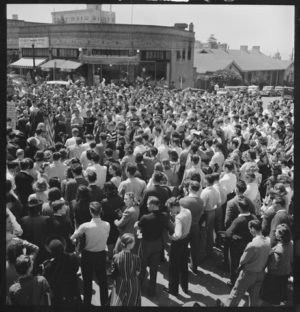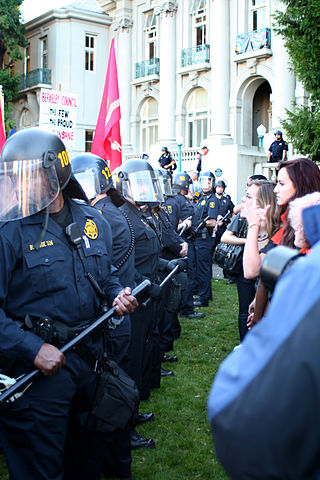
When good ol’ boy D’aron Davenport from ‘Welcome to Braggsville’ lets it slip that his hometown in Georgia hosts an annual Civil War reenactment, his new friends at UC Berkeley plan to stage a protest in the form of a “performative intervention.” Dramaturg Rebecca Fredrickson dives into the history of liberalism and protest at UC Berkeley.
Berkeley has a long history of left-wing protesting on a variety of topics. In the 1930s, Berkeley students led massive protests against the coming war and the end of the disarmament policy. Demonstrations continued throughout World War II, including anti-fascist protests. From 1949-1950, students protested against the anti-communist loyalty oath that Berkeley professors were forced to take; at the time, these were the largest student protests ever witnessed in America.
This was the background for a series of protests throughout the 1960s that were connected to the Civil Rights Movement, the Free Speech Movement, and protests against the Vietnam War. First, in 1964, thousands rallied to protests racially discriminatory hiring practices at the Sheraton Palace, a hotel in San Francisco. In response to the high numbers of students involved in the protest, the Berkeley administration declared that political organization was no longer permitted at a certain intersection, Bancroft and Telegraph, that had served for many years as a gathering place for political groups. Later that year, a student, Jack Weinberg, was arrested for violating this rule, causing students to sit down around the police car containing Weinberg so that it could not leave through the night and into the next day. This resulted in the signing of an agreement between the administration and representatives of political groups on campus. That December 1500 students occupied Berkeley’s Sproul Hall as a sit-in protest against the proposed expulsion of Weinberg and other on-campus activists. Ultimately, 773 students were arrested for their involvement in the protest. Later, over 10,000 people marched through Oakland on November 21, 1965 to protest the Vietnam War. The march was organized by students who formed a committee during an on-campus protest. This march was the first large-scale public protest against the Vietnam War.
These protests were not without opposition. For example, during the marches, there were several instances of people, especially members of motorcycle clubs, breaking through police lines and physically attacking protesters. Perhaps the most famous instance of protest violence on Berkeley’s campus came with the People’s Park riots, also known as the Battle for People’s Park. The Park was an area of vacant land that students had turned into a community park and a haven for anti-war protests. However, the university wanted to claim this land back. Then-California governor Ronald Reagan authorized law enforcement to use “whatever force is necessary” when evicting students from the park. Armed with bayonets and shotguns, officers fired buckshot indiscriminately into the crowd of thousands of protesters. One student, James Rector, was killed, and scores were injured in the confrontation, including 111 police officers. These events became known as Bloody Thursday. Even afterward, for days riot police and helicopter tear gas drops were used in an attempt to gain crowd control. Over 400 protesters were arrested. (For the record, People’s Park is still a community park to this day.)

The incidents I’ve listed are only a few of the most visible in the long history of protests on Berkeley’s campuses, which have spanned such diverse issues as apartheid, police brutality, the Israel-Palestine conflict, and immigration rights. Tensions are still incredibly high on campus. Just this February, there was a borderline riot on the campus in response to a scheduled speaking engagement by Breitbart editor Milo Yiannopoulos. Though the university officially decided that the Berkeley College Republicans – a student organization – had the right to host Yiannopoulos, over 100 faculty members signed letters of protest, and approximately 1500 people came to protest Yiannopoulos on the night of the speech. The protests turned violent when, according to Rolling Stone’s Matt Saincome, “roughly 150 black-clad, anti-fascist radicals with clubs and shields lit fires, hurled Molotov cocktails, smashed windows and caused enough of a scene to achieve their objective: deny Yiannopoulos the opportunity to spread what they view as dangerous hate speech at the university’s new Martin Luther King Jr. Student Union Center.” As a result, the engagement was canceled. There have also been instances of anti-fascist protestors physically attacking Trump supporters in the wake of the inauguration. This has caused major debate about what actually constitutes free speech according to militant Berkeley protestors. Even more recently, the university canceled a planned speaking engagement by famous conservative author Ann Coulter, citing specific threats by on-campus anarchist groups. As of the writing of this paragraph on April 24th, two conservative organizations have officially filed a federal lawsuit accusing the university of trying “to restrict conservative speech.” All in all, it is clear that Berkeley has not changed much from its majority-liberal, protest-happy roots.
This sort of devout liberalism is not unique to Berkeley; rather, it can be seen with increasing frequency across highly selective schools. Author William Deresiewicz wrote an essay, titled “On Political Correctness“, that dismantles the processes by which the liberal elite perpetuates itself on elite liberal college campuses. He argues that political correctness has come, for liberals, to mean “the persistent attempt to suppress the expression of unwelcome beliefs and ideas.” He draws upon his experience at a variety of college campuses to illustrate how students are taught to actively silence themselves if they have opinions that deviate in any way from the radical liberal norm, including Zionism, conservatism of any kind, and even religious belief. He argues that “Selective private colleges have become religious schools. The religion in question is not Methodism or Catholicism but an extreme version of the belief system of the liberal elite […]. To attend those institutions is to be socialized, and not infrequently, indoctrinated into that religion.”
He also points out that at these institutions, the “student populations largely come from the liberal upper and upper-middle classes, multiracial but predominantly white, with an admixture of students from poor communities of color—two demographics with broadly similar political beliefs, as evidenced by the fact that they together constitute a large proportion of the Democratic Party base. As for faculty and managerial staff, they are even more homogenous than their students, both in their social origins and in their present milieu, which tends to be composed exclusively of other liberal professionals—if not, indeed, of other liberal academics. Unlike the campus protesters of the 1960s, today’s student activists are not expressing countercultural views. They are expressing the exact views of the culture in which they find themselves […].” While there is diversity of identity, especially with regard to race, gender, and sexuality, “in terms of ideology, they are all but homogenous.”
In my opinion, this essay does an amazing job of outlining many of the issues at play in Welcome to Braggsville‘s Berkeley. I highly recommend that everyone reads it.
The razor-sharp Welcome to Braggsville runs June 7-July 2, 2017. Tickets available here.